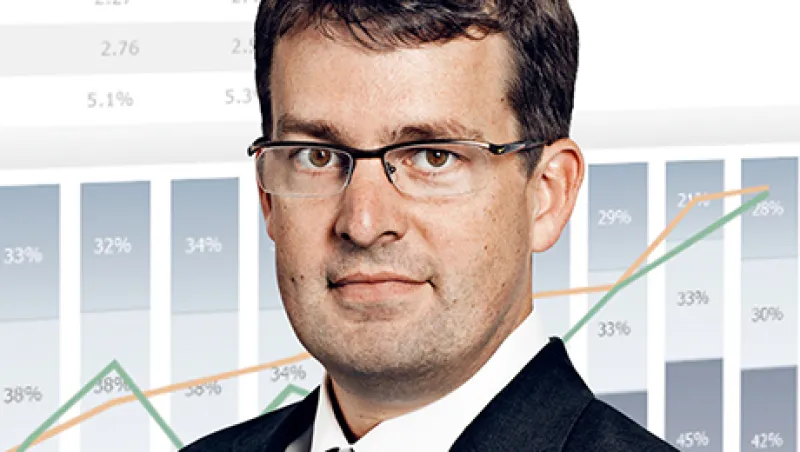By just about any measure, the British economy has been on a tear recently. The U.K.’s gross domestic product expanded by 0.8 percent in the second quarter, putting it on track to grow 3.2 percent this year, one of the highest rates in the developed world. The pound sterling has kept pace, rising more than 11 percent in the past year against the U.S. dollar. The question on foreign exchange traders’ minds: How high can the pound go?
One of the most optimistic forecasts comes from Barclays Bank, which sees it continuing to appreciate to $1.71 by year-end, from $1.67 in mid-August. But other currency strategists see the pound losing steam later in the year, particularly versus the greenback.
The main driver of sterling strength has been interest rates. Bank of England governor Mark Carney shocked markets in May, when he said in his annual Mansion House speech that the U.K. central bank might raise its benchmark rate from 0.5 percent, where it has remained since 2009, sooner than expected. Analysts had been anticipating that Britain would start doing so next year, but after Carney’s speech they moved up that expectation to this fall. That would make the U.K. the first Group of Ten nation to hike interest rates after years of stimulus following the 2008–’09 recession.
Investors pile into currencies with the highest return, notes Marvin Barth, European head of forex research at Barclays. “The U.K. economy has been doing very well,” he says, pointing out that after six quarters of growth it is now back above precrisis levels.
When Carney took over as BofE governor last year, he championed quantitative easing — buying bonds to drive down interest rates — and offered dovish forward guidance on interest rates, warning traders directly that the central bank probably wouldn’t raise rates as soon as they anticipated in 2015. His abrupt change of direction in May caught markets off guard.
Then, in August, Carney confused matters in his quarterly inflation report by noting that there had been “remarkably weak” British wage growth. That caused a U-turn in market thinking about the timing of the expected rate rise.
Still, Barclays also sees signs that the U.K. economy may be rebalancing away from consumption toward other sectors, Barth says: “In the last quarter of 2013 and the first quarter of this year, there was a tantalizing growth in net exports.” Such measures as the rate of investment growth are also probably at the top of the list in the G-10, he adds.
John Hardy, Copenhagen-based head of forex strategy at Saxo Bank, says the pound may advance slightly against the euro this year because the European Central Bank has set a course of lower interest rates and has even hinted that it will use quantitative easing as a tool to reduce the euro’s value. He sees the euro finishing the year at 78 or 79 British pence, pretty much where it is today, and sterling at $1.62. “Everyone is falling over themselves anticipating the Bank of England’s removal of accommodation and the normalization of interest rate policy,” Hardy says. “It justified some degree of sterling strength, but I think it was overdone. I think sterling is overvalued versus the dollar for sure.”
That also was the view of the International Monetary Fund, which issued a report on the British economy at the end of July. Although it lauded U.K. growth, the report said the pound was overvalued by 5 to 10 percent against the dollar.
Christian Apelt, a Frankfurt-based currency analyst at Helaba Landesbank Hessen-Thüringen, says the pound has already begun to turn lower, a process he expects to continue throughout the autumn. He forecasts that it will fall to $1.58 by the end of the year. “I think sterling is turning because of the discussion in the United States about a more restrictive Fed policy,” Apelt says. “The Bank of England story is already priced into sterling.”
Barclays’s Barth agrees that the dollar will probably begin appreciating against the pound after the Bank of England makes its first interest rate increase. The reason, he says, is that, with inflation low in the U.K., the British central bank can increase rates more gradually, whereas the Federal Reserve Board will have to be more aggressive in boosting its own rates because it waited longer.
One wild card in the U.K. is the run-up in housing prices, which has put the government under pressure. “Sterling has been supported by a ridiculous housing bubble, in London especially,” Saxo’s Hardy says. “Capital flows into the U.K. to be parked in real estate, where the carrying costs are zero — no property taxes — and the government pursues a policy of not allowing building.”
The BofE has announced macroprudential measures to cool the housing market, including limiting loan-to-income ratios. But it’s resisted calls to raise interest rates to deflate the property bubble.
Another unknown is the September 18 referendum on Scottish independence. Apelt expects the pound to take a small dip as the date nears, but because virtually no observers believe the referendum will pass, it will have little impact on the currency, he says.
Hardy also warns of the possibility of a squeeze on the pound caused by a sudden reduction in what’s called risk-on investing. If investors flee riskier markets toward safe havens like the dollar and the euro, which have greater liquidity than the pound, those who have bet on an appreciating sterling could get clobbered, he notes. • •
Get more on foreign exchange.






